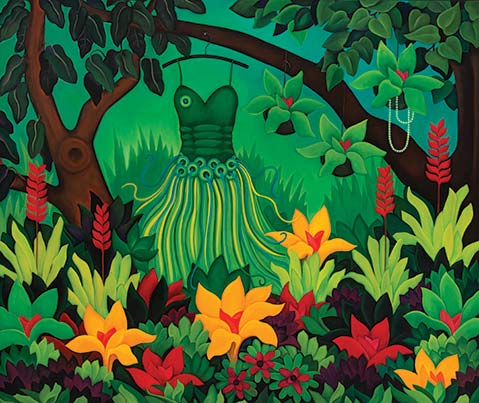‘Earthly Delight,’ an Ode to the Natural World
Artist Angela Perko Presents a Mythical Almost-Garden of the Imagination

An oversized magnolia blossoms. A deep green forest vista featuring a solitary dress on a clothes hanger beckons. A white heron perches in a boxed foreground against a striking Japanese garden scene. These inviting and mysterious depictions of garden landscapes by Angela Perko, an area artist and co-owner of Santa Barbara’s Lost Horizon Bookstore, invoke a deeply mysterious sense of sensuality and narrative without simple answers. Four large tableaus and numerous small and medium pieces, all oil paintings, can be seen at her exhibition Earthly Delight from now until November 29 at Sullivan Goss art gallery. The overall effect of the show is of having strolled through a strange, mythical, almost-garden of the imagination, culled deep from an artist’s mind.
In many of the show’s works, Perko’s paintings actualize a stylized natural world that is both supremely feminine and erotically mysterious. Perko’s images contain the living beauty of a woman’s desire, and this idea is gorgeously perfected in “Her Dress Hangs Here.” The focal point of the painting is a green, striped garment that appears part animal, with ribs, an eyeball, and a skirt that flow’s like the tail of a fish. This dress appears to move independently, free of the woman wearing it, and the dress itself acts as a delicious metaphor for the way female sexuality cannot be tamed, subdued, or destroyed. Red love hearts erupt from the centers of blossoming flowers that could be ginger or some other tropical blooms. Breathing alone deep in an unspoiled forest, feminine desire appears aloof, untouched, and perfect.
In addition to the botanical and subtle erotic themes throughout the exhibition, Perko uses formal geometry in various pieces, with uneven results. In the large piece “Between the Lemon Trees,” a dramatic red-and-green, yellow-and-black palette, along with a symmetric composition, strike a strong, masculine chord that boldly conflicts with the loose curves of many of the other paintings. In “The Garden of Dreams” and “The Garden of Good Fortune,” however, the works seem to capture neither the curvaceous sex appeal nor the strict order and dramatic color of the more masculine works and fall slightly flat, although Perko’s clear skill with color and composition are apparent.
Several of her other paintings also blend the free-form curviness of flowers with the rigid order of corners and straight lines. This tension is most effective in “Lillies,” a still life of a bouquet bisected by lines and windowpanes of distorted shapes. A simple floral image complicated by shapes, the image is reminiscent of flowers reflected in a broken looking glass, like loveliness that has been overthought, complicated, and disrupted.
A cluster of close-up paintings of flowers prove Perko’s familiarity with the garden. However, compared with the lush compositions of the large works, these smaller, single-subject images fail to show the artist’s extensive range or fully capture her dynamic, painterly potential. Still, they seem designed to prove Perko’s love for and interest in actual flowers from real landscapes; it is clear that Perko wants people to remember that they live in a place where blossoms and greenery are taken for granted because of their omnipresence.
In their entirety, the paintings awaken the viewer to the fact that they live in a place adorned year-round with flowers and plants. Perko’s flowery vistas echo the garlands on display everywhere in Santa Barbara County. This, by itself, is a supreme feat, and the paintings successfully mirror and distort and complicate the notion of natural beauty through the intriguing hand of a woman who knows her blooms.



